INTERLUDE









The Collaborative STABLE
Curator’s Foreword
Nancy Daly
Leigh Davis
Rex Delafkaran
Tim Doud
Adrienne Gaither
Claudia “Aziza” Gibson-Hunter
K Lorraine Graham
Jean Kim
Leah Lewis
Matthew Mann
Katherine Tzu-Lan Mann
Gail Shaw-Clemons
Molly Springfield
Andy Yoder
Ying Zhu
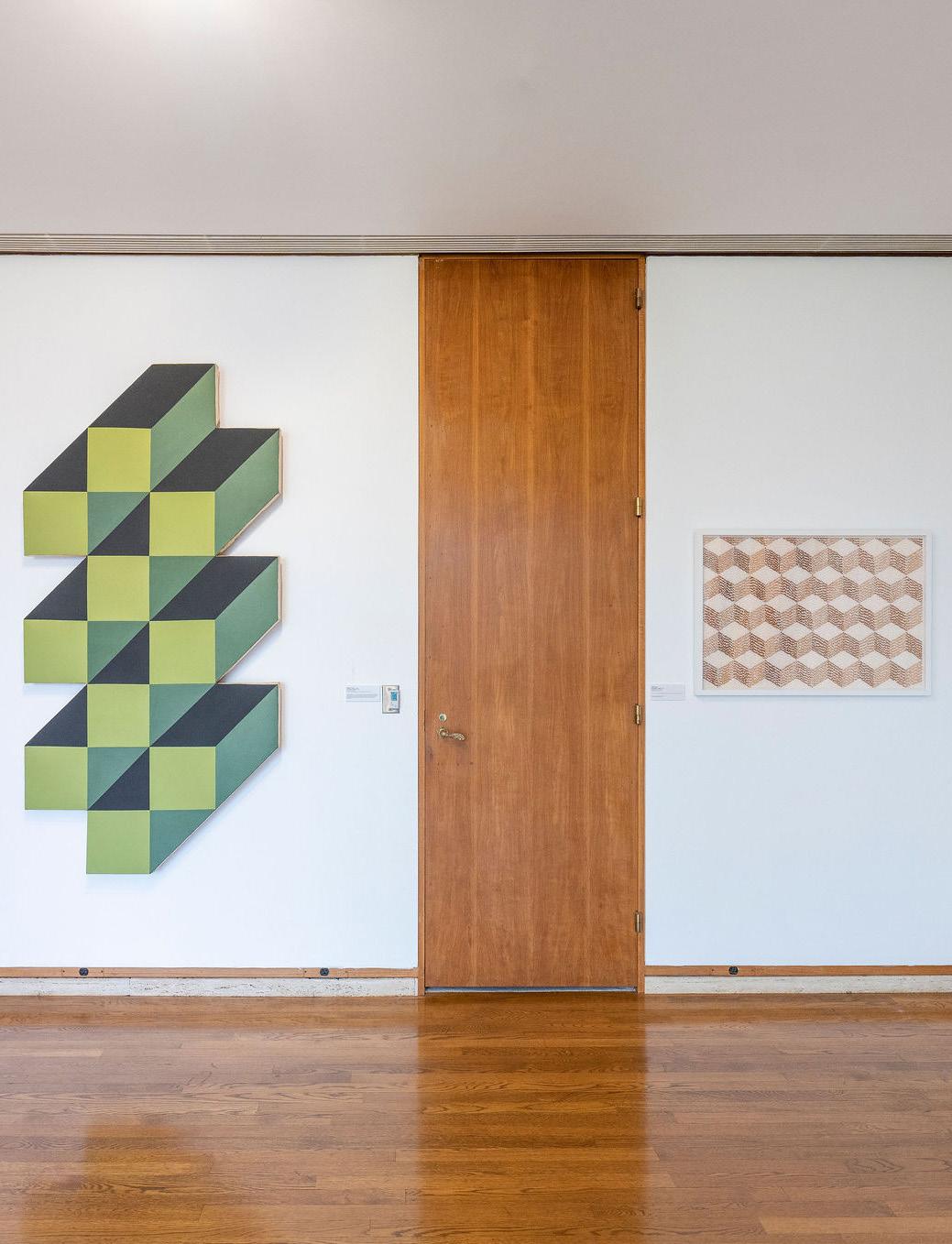
February 1980 Washington Dossier
David and Carmen Kreeger were devoted patrons of the arts and the Washington, DC arts community. They supported countless Washington-area artists including Sam Gilliam, Simmie Knox, Thomas Downing, Gene Davis, Morris Louis, Ed McGowin, and Albert Stadler, purchasing their work at the Corcoran Gallery of Art biennials, area galleries, and directly from artists in the 1960s and early 1970s.
The Kreegers believed that the key to a good life was sharing; they shared their love of art and their collection by opening their home to visitors a few times a year and they loaned many paintings to art museums as well as universities. In addition, the Kreegers established arts awards at Georgetown University, George Washington University, and Catholic University.
I am pleased to honor the Kreeger legacy of supporting Washington artists through The Collaborative, a program presenting powerful and thought-provoking exhibitions. We are thrilled to be in partnership with STABLE to present this exhibition and honored to champion these artists, providing many of them the opportunity to present their work in a museum for the first time.
Helen Chason Director The Kreeger Museum“Acitywithoutarichartisticlandscapeisnotacity”

STABLE is a space for artists to think and create, fostering an arts ecosystem in DC through our studios, residencies, projects, and collaborations. STABLE provides affordable studio spaces to area artists and short-term residencies for national and international partnership.
Music came to mind when thinking about the arrangement of these modernist and contemporary artists. Like visual art, music is a timeless, culturally oriented, yet universally relevant experience. As Russian painter and theorist Wassily Kandinsky encouraged, “Lend your ears to music, open your eyes to painting, and... stop thinking! Just ask yourself whether the work has enabled you to ‘walk about’ into a hitherto unknown world.” This quote reflects much of Kandinsky’s philosophies about art, its purpose, and its seeding intention; there is a desire to push beyond expectation and seek inner merriment. Therein lies the underpinning of “interlude” as a binding concept for this exhibition; this pause and in-betweenness ties these artists together across many generations and geographies.
Interlude: “an intervention” or “intentional interruption”, describes this active meeting of modern and contemporary artists. The exhibition expresses the poetics of relation as these artists work with common aesthetic and conceptual interests, reflecting and responding to precious environments of modernity. These artists meet through their approaches and applications to mirror, respond to, and complement each other. This interlude is the moment in-between collective past and future and the present moment of the artist’s practice.
With a large, cascading sculpture drawing audiences down the museum’s central staircase, Andy Yoder’s Pileup, assembled with salvaged auto parts, references David Lloyd Kreeger’s tenure at Geico Insurance as Chairman and Chief Executive Officer. Keeping the technological advancements of the modernist arena in mind, it is befitting that amid new forms of travel technology, Yoder repurposes the old, especially as our consumption and relationship with technology produce massive ecological dilemmas and degradation.
Oriented more to the spirit than our physical faculties, Aziza Gibson Hunter’s Gris, Gris are charged with the emotional impact of color and engages the relationship between the visual and sonic sensibilities. Cut paper extends the square geometrical limitations within their frame, and colors intermix in unexpected swatches. The sporadic dancing bursts of color in Kandinsky’s Relations are akin to the floating nature of the Gris, Gris as standalone work and within this more extensive series.
Color and geometric form are further explored with Ying Zhu, Tim Doud, Nancy Daly, and Jean Kim’s contributions spanning media. Katherine Tzu-Lan Mann’s Analemma, paired with Paul Jenkins’ Phenomena Lunar Reckoning, explores the fluidity of ink and paint as it flows freely within the conscious restriction of the artist’s hand. Matthew Mann uses color in a surrealist way to convey landscape, an interest fostered by its historical limitations and more physiological elements. Similarly, Adrienne Gaither’s This Won’t Save Me speaks to an awareness of spatial limitations and their reflection on the built, social, and psychological
environments. These landscapes, respectively in conversation with the work of David Urban and Milton Avery, highlight color as the primary force guiding the composition.
Engaging time, K. Lorraine Graham’s performance-based writing installation, Study, is in response to Thomas Couture’s Seated Nude in Landscape. This feminist intervention would not be possible without the passage of time, expanding societal understandings of gender, sexuality, and autonomy. Molly Springfield’s graphite drawing, mutually destructive, is a rendering of a Virginia Woolf’s To the Lighthouse text excerpt. The reference to Woolf is connected to Joan Miró, who respectively engaged subgenres of surrealism and automatism in his work. Leigh Davis joins this gathering, considering the future— life after death. Her video, Workshops, explores end-of-life experiences and engages various cultural and religious beliefs. Some of the collaged visuals in the film have been appropriated for new life and function, transitioning and repurposing their practical applications and connotations.
Leah Lewis shares a fascination with the physiological components of death. Her abstracted still life, Rotten Pear, captures the decomposition process that produces nutrients amid decay. Rex Delafkaran balances abstraction and representation with Walkflag (Exarcheia, Greece), which is placed in relation to Helen Frankenthaler’s painting, Hurricane Flag. Imbued with landscape, Walkflag uses images of the ground taken by Delafkaran on a walk across Athens, Greece to further abstract the compositional make-up of a flag, and ponder its symbolic function.
Gail Shaw-Clemons’ Masks reflect African Americans’ continual reach toward the African Diaspora. Made amid the Black Lives Matter Movement and embellished with its slogan, we see similarities to the Africana aesthetic in the illustrations of Aaron Douglas. FIRE! Magazine, based in the cultural capital of Harlem durings its literary insurance in the 19020s, was illustrated by Douglas and worked alongside other African American publications to document urban life. Amongst other notable visual motifs, masks and iconography of Africa were employed as means of socio-cultural and philosophical posturing. Africa was in conversation with The West; the socio-cultural technologies on the continent were visualized as a connection for the global majority.
The art included in this exhibition is not a response but more a relationship between artists looking at the rapid developments of nations, sociality, technology, and the human hand on the natural environment. Together, these artists, past and present, reflect an inner curiosity as informed by their worldview. With a primacy of color, abstraction, and material exploration, this interlude is a pregnant pause of possibility.
Maleke Glee Director of Art and Programming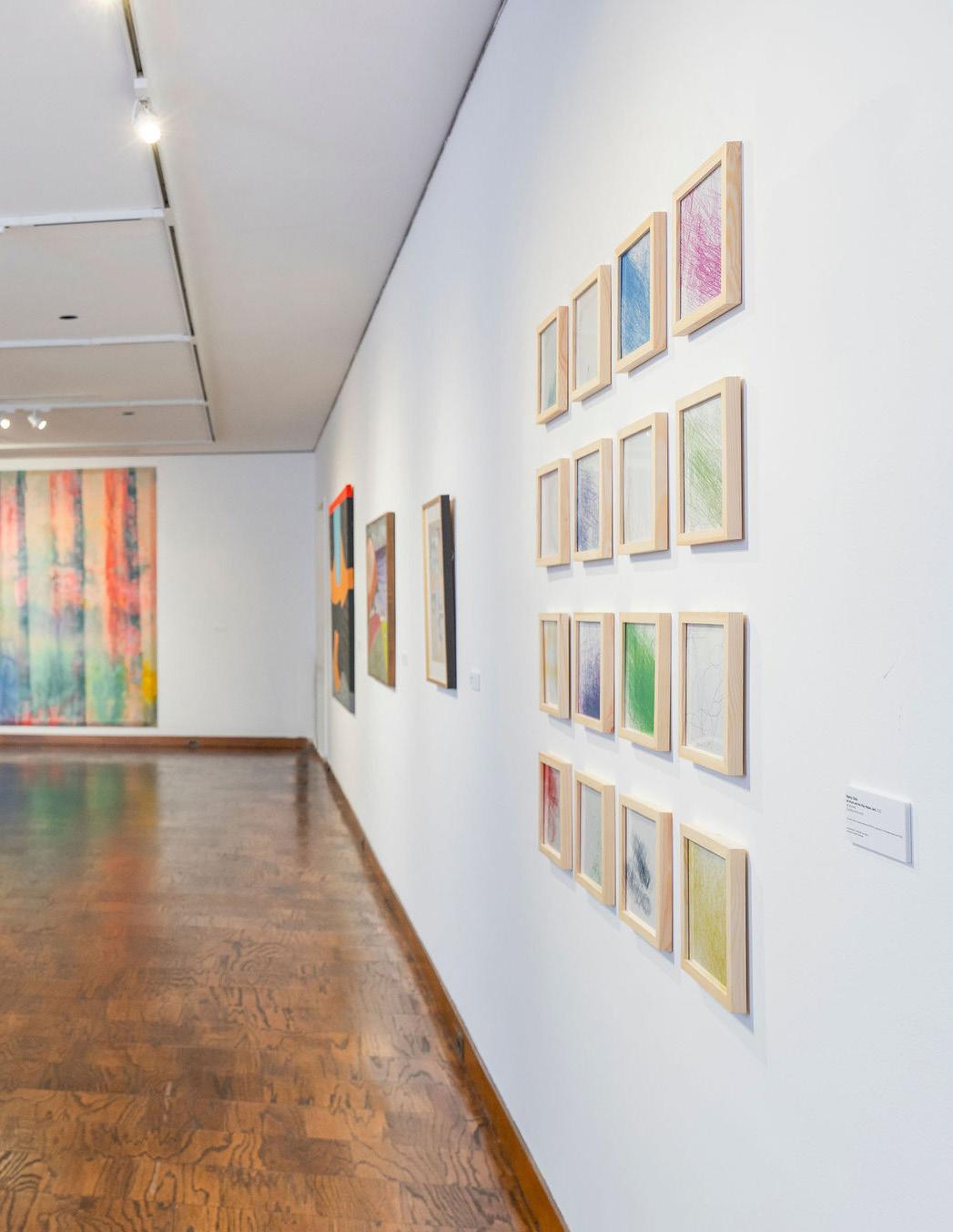

nancy-daly.com
@nancydaly
Nancy Daly is a Washington, D.C.-based interdisciplinary artist whose work examines systems created and/ or perpetuated by technology and the effects these systems have on identity and social behavior. By creating interactive machines reminiscent of outdated technology, prints, replicas and sculptures, she addresses the contradictions present in various technology that are at once ephemeral and entirely permanent and challenges the viewer to look beyond the user-friendliness of online technology and consider what their participation in these technologies mean. Daly earned an MFA in Photographic and Electronic Media at the Maryland Institute College of Art (MICA) and holds a B.F.A. in Studio Art with a concentration in Graphic Design from James Madison University. She is an alum of the Hamiltonian Artists Fellowship Program (20142016) and maintains a studio practice at Stable Arts. Recent exhibitions include solo shows at Gallery 406 at Elon University (Elon, NC), New Image Gallery at James Madison University (Harrisonburg, VA) and Julio Fine Arts Gallery at Loyola University Maryland (Baltimore, MD). Daly is the co-founder of but, also, an artistrun space in Washington, DC dedicated to the sustaining of art practices, in a multitude of forms, through a series of short-term projects.
Wassily Kandinsky, Contrasts, 1937, gouacheongraypaper Nancy Daly, AllWorkandNoPlayMakesJack, 2022, ink jet printsMy most recent body of work, Ruminations are visualizations of time wasted. To ruminate is to mediate or muse, to ponder, to brood. There is no completion to the thought, there is only the thought, performed over and over, often resulting in increased anxiety. It is simply the act of thinking, the work of thinking, with no conclusion. Ruminations labor over the ideas of work and time in the era of late-stage capitalism. It explores the absurdity of this era, the impulse for constant productive action, and how this changes our relationship to time. Through solitary durational performances in which I perform a single action simply for the sake of performing the action I reference a productive, purposeful form of work but the products of said work in this case are pointless, non-functional objects. They are repeated to a point of destruction –absurdity to challenge the notion of productivity. They are documented and presented as complete objects representing a specific period of time, although they could be added to ad infinitum.
Each drawing in All Work and No Play Makes Jack is created in the absence of my hand as 3 computer mice work continuously with the aid of mouse movers and a computer program to complete a series of drawings on the computer. Each drawing represents a different period of time when, while the mouse movers continued to work, I was free to go about the rest of my life; making dinner, attending a wedding, sleeping, attending a faculty meeting, packing for another exhibition, etc.

leighdavisprojects.com
Leigh Davis is an interdisciplinary artist. Her work explores grief, memory, and storytelling – how these universal experiences help define what it means to be human. Trained as a photographer, her work now ranges across media, from sculpture and installation to sound, performance, and video. In recent years, Davis has been producing a body of work about end-of-life experiences (ELEs)—in particular, how they help us understand the emotional intricacy of grief and the ways in which we construct our beliefs about human consciousness and a possible afterlife. Her film, Inquiry into the ELE (2016-2019), was exhibited at Vox Populi (Philadelphia) in April 2020. Her site-based audio installation, Vigil, featured at Green-Wood Cemetery (Brooklyn) in September 2020. Davis has shown work at Open Source (Brooklyn), BRIC (Brooklyn), EFA Project Space (New York), Oliver Art Center at CCA (Oakland), and MICA (Baltimore). She has created performances for the Morbid Anatomy Museum (Brooklyn), Dixon Place (New York), the Hirshhorn Museum (DC) and Jeff Marfa (Marfa). Davis is the recipient of numerous grants, including from The Pollination Project, The Puffin Foundation, and the DC Commission for the Arts and Humanities. She was selected to be a part of the first Public Interest Design Lab fellowship in collaboration with the DC Public Library and the Goethe Institute in 2021. A native of Pittsburgh, Davis is a Part-Time Assistant Professor at Parsons the New School for Design and currently works between Brooklyn, NY and Washington, DC.
 Left: Brian Michael Dunn, Acrylic on canvas
Left: Brian Michael Dunn, Acrylic on canvas
Humans attempt to predict the future by manipulating memories of the past. Scientific studies have modeled how our brains produce simulations of future events by drawing on personal memories, stories told by families and friends, and pop culture. This function of our imagination can help us cultivate excitement for milestone events or allow us to problem-solve potentially stressful situations. But can we use it to predict what’s on the other side of death?
Over the past 8 years, I have built a body of work exploring end-of-life experiences (ELEs). My project Inquiry into the ELE (2019) is a collaborative study that takes the form of a filmic essay, featuring illustrated true accounts of individual end-of-life experiences during or following the death of a loved one. Recently, I have been conceiving a project that investigates how we construct our beliefs about human consciousness and a possible afterlife, with a particular focus on how abstraction, imagery, and non-linear narrative help us process discomfort and imagine decisions based on assumptions about our lives and deaths. The selected videos are reflections on Vanitas, the transience of human life, which comes from the biblical phrase “vanitas vanitatum et omnia vanitas” (vanity of vanities, all is vanity). Akin to the memento mori, it is a warning to the ephemeral condition of existence.
As Braque rendered his state of mind through images with symbolic objects of mortality, faith, and ritual, these echo a direct face to the fact of death. Created in the wake of a global pandemic, I share in the process of unfolding what may not yet be conscious.
 Leigh Davis, Workshops, 2022, video
Leigh Davis, Workshops, 2022, video

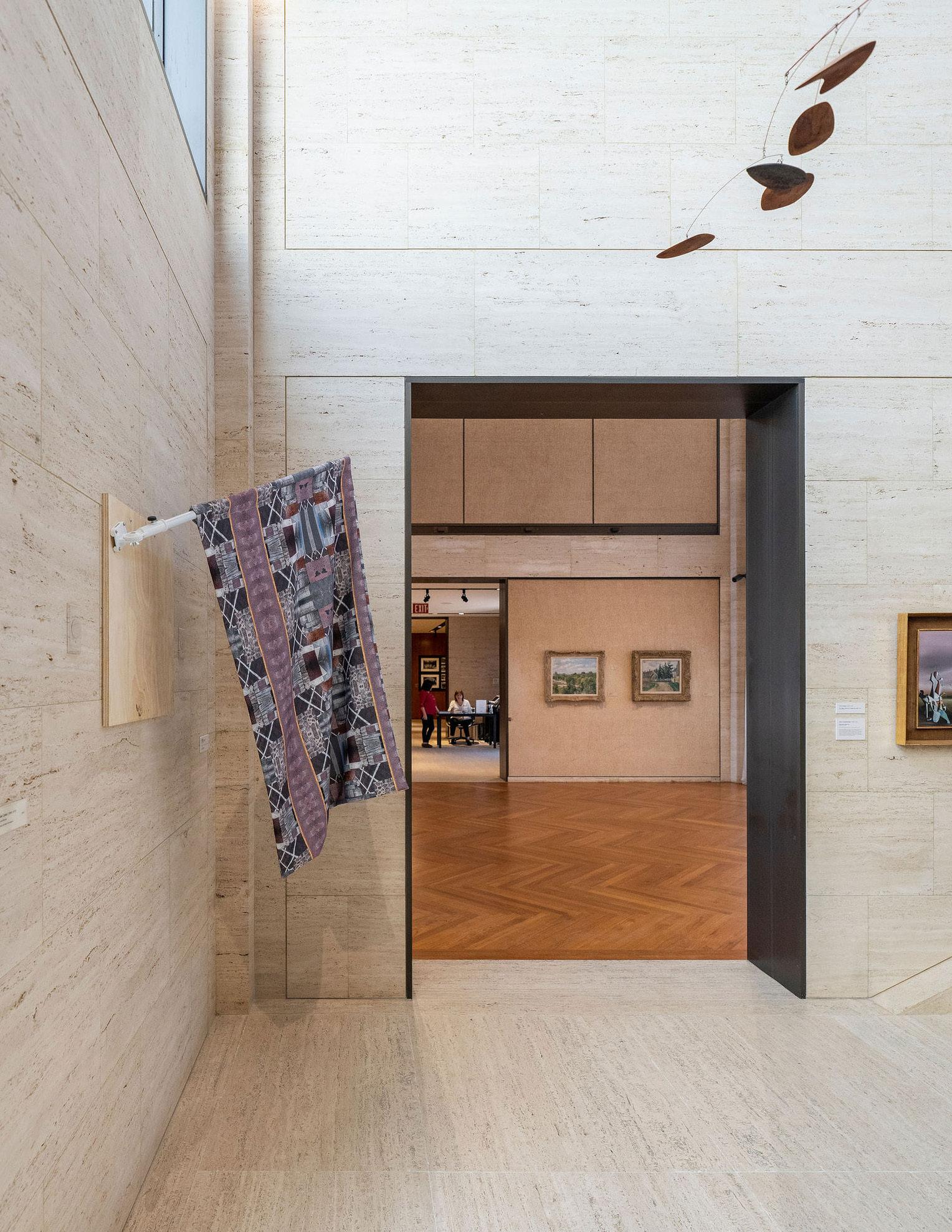
rexdelafkaran.com
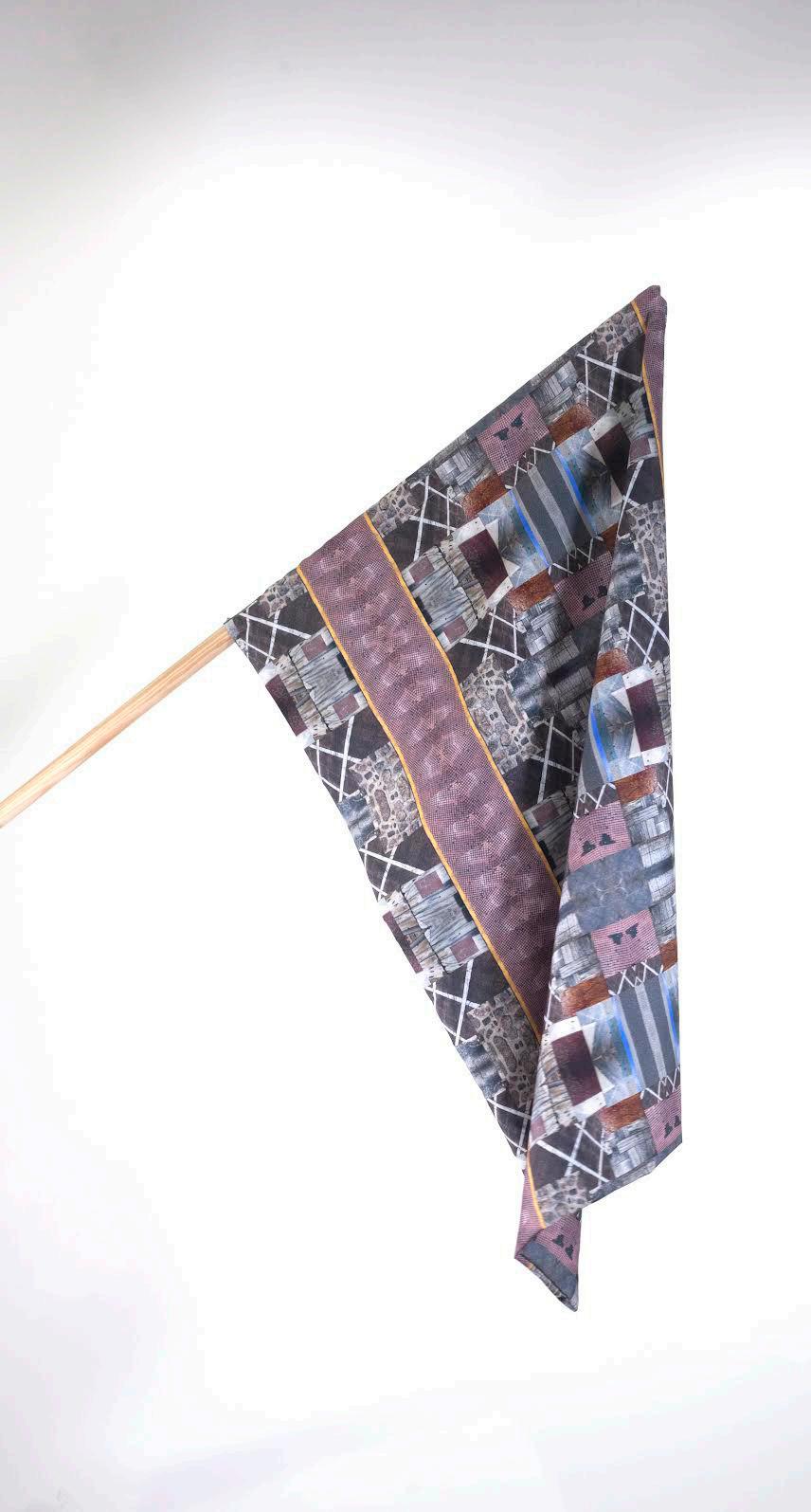
@rex_delafkaran
Rex Delafkaran is an IranianAmerican interdisciplinary artist and dancer from California, based in Washington, DC. Delafkaran holds a degree in Ceramics and Performance Art from the San Francisco Art Institute. Using movement and objects she explores ideas of failure and hybridity among bodies, objects, identities and language. Delafkaran has exhibited and staged performances at the Smithsonian Hirshhorn Museum (Washington, DC), Panoply Performance Lab (Brooklyn, NY), Platform Art Fair (Athens, GR), Satellite Art Fair Miami (Miami, FL), Southern Exposure Gallery (San Francisco, CA), and the Textile Museum (Washington, DC) among others. She is a recent recipient of a NARS Foundation International Artist Residency Fellowship and a Warhol Foundation Wherewithal Research Grant. She is also the co-founder and co-director of but, also an artist-run space that sells artist made products, produces exhibitions and works with a mission of empowering artists to both selfsustain and experiment. Delafkaran makes her work at STABLE Arts studio in Washington, and exhibits and performs nationally and internationally.
The foundation of my practice is rooted in methods and acts of translation and language. I am playing with materials to discover hybrid forms and functions, abstract languages, and explore narratives of IranianAmerican and queer identities, real and invented. Through frameworks of hybridity and simultaneousness, my work translates ideas physically through live performance, multimedia documentation, ceramics, sculpture and dance. When deployed in concert these ideas ask questions and have the possibility to invent new ways of understanding. Tied up in the aesthetics of identities, functional handmade and readymade objects, and the language of dance is a dedication to the notion of failure, and an active impulse to try. I am interested in what languages and materials we have at our disposal to make meaning, where the emotional mythologizes utility and identity, and how we can reconsider the literal and cultural functions of objects and bodies.
I’m interested in the body as a tool and objects as bodies, and through the use of my own both as a performer and a maker I am wading through personal, cultural minutiae to form the languages at work in my practice. Questions surface from the tensions between objects like cinder blocks and crafted ceramic vessels, or a ceramic dildo on a Persian carpet. My performance-based practice explores the ways we translate our personal and historical archives into our bodies, and how haptic translations deepen and hybridize existing knowledge. By visualizing and embodying language, I investigate the humor, formal relationships, and discomfort found when ideas are expressed with or through a specific body, shape, or material. My practice settles into divergences of material to make evident the intertwined languages of identity, utility and legibility.

timdoud.net
@timdoud_art
Tim Doud’s paintings and drawings address two seemingly distinct bodies of work, one figurative and one abstract. These bodies of works serve as a backdrop to broader discussions around constructed identities, branding, and commodity culture. Doud graduated from The School of the Art Institute of Chicago with an M.F.A. in Painting and Drawing. He also attended the Skowhegan School of Painting and Sculpture in Skowhegan, Maine. Doud has exhibited his work at Curator’s Office in Washington, DC; Galerie Brusberg, Berlin, Germany; Art Basel, Basel, Switzerland; MC Magma, Milan, Italy; Priska Juschka Fine Art, New York, NY; RAYGUN, Toowoomba, South Queensland, Australia; Mono Practice, Baltimore, MD; and the New Bedford Museum of Art. His work has also been included in exhibitions at PS1 (MOMA), New York, NY; Corcoran Gallery of Art, Washington, DC; Artists Space, New York, NY; Frye Art Gallery, Seattle, WA; Tacoma Art Museum, Tacoma, WA; Kemper Contemporary Art Museum, Kansas City, MO; and the Smithsonian’s National Portrait Gallery, Washington, DC. He has received grants from the National Endowment for the Arts (Arts Midwest), Pollock-Krasner Foundation, and DC Commission for the Arts and Humanities. and has participated in residencies at The Banff Centre, Alberta, Canada; Sharpe/Walentas Studio Program, New York, NY; and the Golden Foundation, New Berlin, NY.
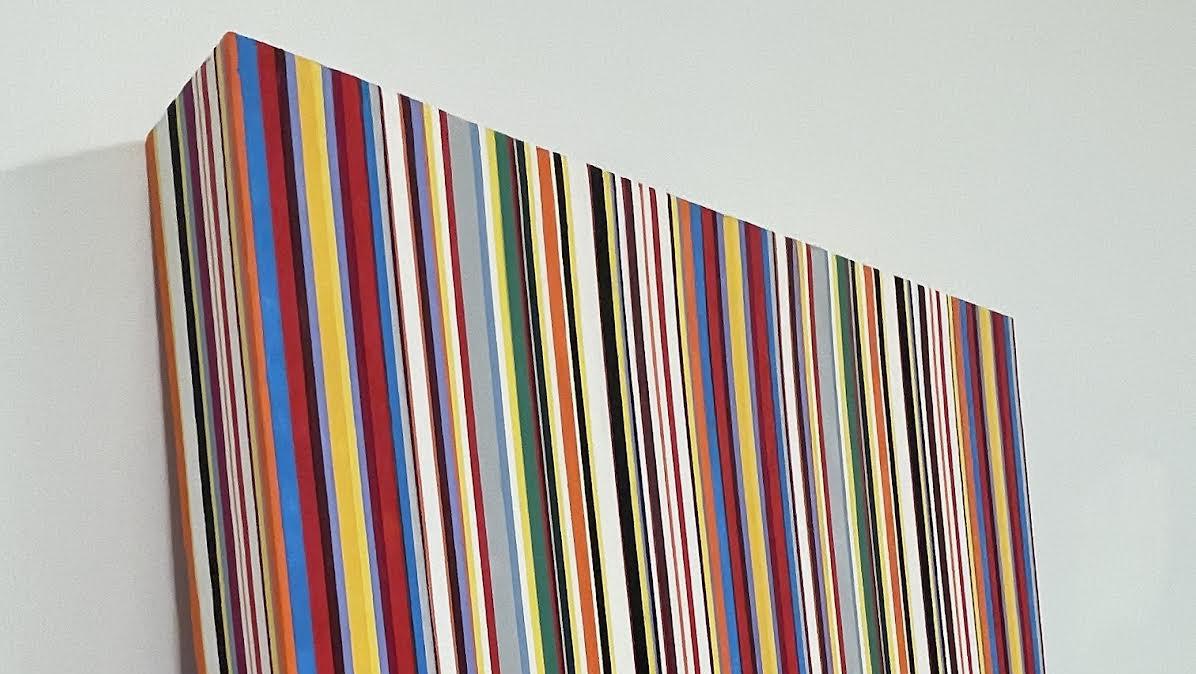
I am interested in the ways painting genres function as practice and cultural signifiers. When I begin a new series of works -- figurative, or abstract -- I establish perimeters -- rules and obstacles governing the craft and development of the work. The cultural referentiality and legibility of a work is key, and often well read by viewers. I like the idea of the viewer recognizing something that they can’t quite place. Something that happens to us all.
I overlay abstract patterns, textures and shapes that signal or operate as signs in some system of representation. Referents emerge from a variety of sources, and these sources are often cropped and shifted from their original source. They are then situated into a new context -- conflated and then expanded as they background the work, literally becoming the ground of the work. A single referent acts as the figure (the top surface of the painting) in the abstract paintings; these reflect, obliquely, the shape of something that is culturally valued or operates as a kind of commodity. The results act as a kind of hybrid of things which intersect or simply appear next to one another.



adriennegaither.com
@rockyyoadrienne
b. 1987 Cincinnati, Ohio
Adrienne Gaither is a visual artist whose abstract paintings explore a variety of topics including race, familial ties, emotional health, class, and the politics of geometric abstraction. She has held solo exhibitions at Transformer in Washington, DC; Museum of Contemporary African Diasporan Arts (MoCADA) in Brooklyn, New York; and Union Arts in Washington, DC. Her work has been exhibited in a host of group exhibitions at Cuchifritos Gallery in New York; DeNovo Gallery in Washington, DC; and Prizm Art Fair, among others. She has been commissioned by the Smithsonian Anacostia Community Museum, Sundance Film Festival, and PepsiCo. Gaither’s work appeared in Margo Crawford’s 2017 monograph Black Post-Blackness: The Black Arts Movement and Twenty-First-Century Aesthetics, in which Crawford writes of Adrienne’s work: “Gaither’s use of abstraction as a means of critiquing the twenty-first century rhetoric of colorblindness is one of the most powerful usages of black abstraction...”. Adrienne’s work has also appeared in D’ailleurs & dici! #2 and D’ailleurs & dici! #3 by Marc Cheb Sun. In 2018, she was awarded a fellowship from the DC Commission of the Arts and Humanities, a position in which she continues to hold. Adrienne holds a Masters of Fine Arts from Howard University. She currently resides in Washington, DC.
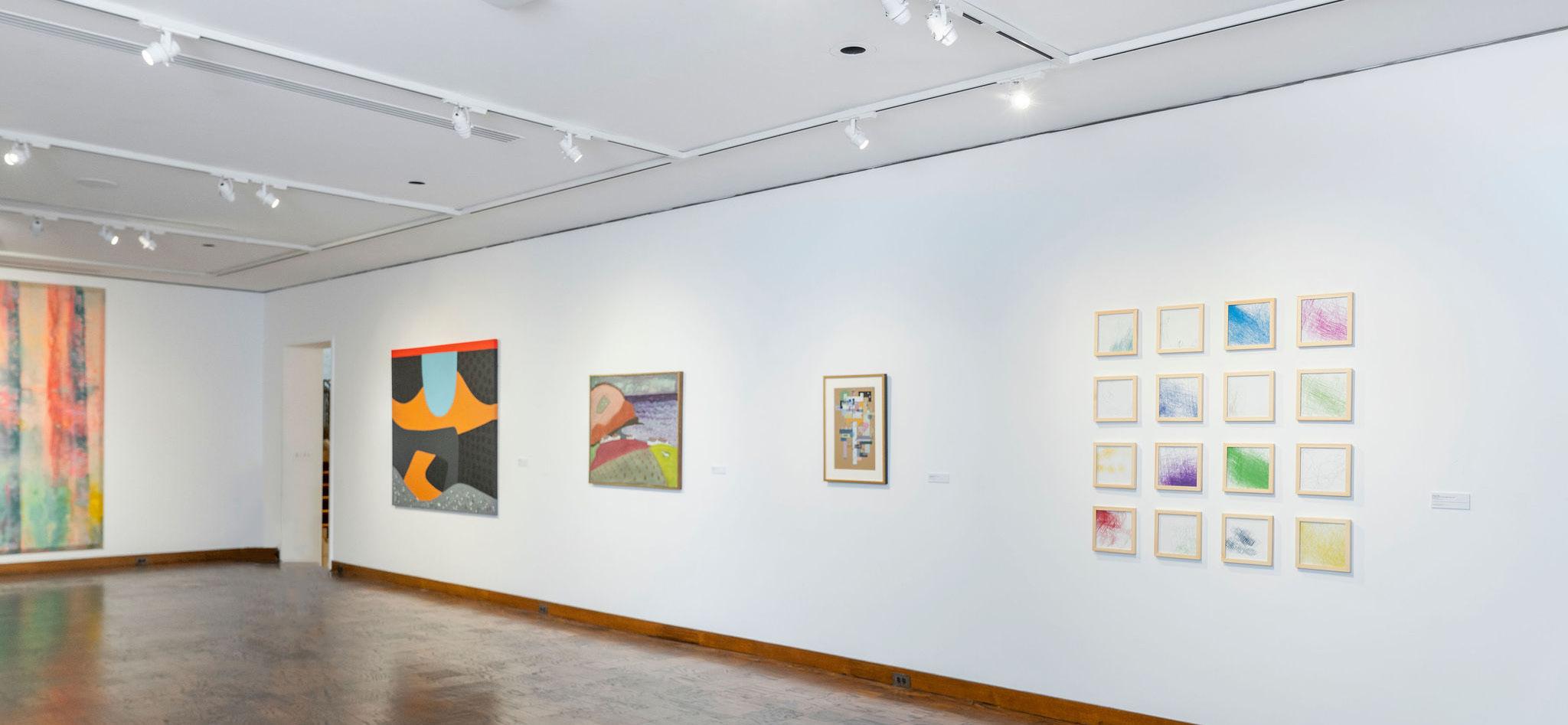
My personal experiences as a Black queer masculine-presenting woman informs my art and practice. By using geometric abstraction, I deconstruct the world as I see it and reassemble it in a way that preserves and encodes the breadth of my perspective. I am aware of the tension between canonized geo-abstract movements such as Suprematism and Constructivism and their aesthetic origins, which are stolen interpretations of indigenous West African pattern making co-opted as tools of intellectual elitism and white supremacy.
Through geometric abstraction, I aim to showcase and celebrate the brilliance and invention of Black aesthetics as a worldwide cultural contribution. My art practice is an act of resistance against the constraining boundaries of the figure and whitewashed art history, providing me with the ability to produce emotionally meaningful and visually compelling works.

gibsonhunterstudio.com @gibsonhunterstudio
Ms. Gibson-Hunter is a mixed media artist who combines painting, printmaking, collage, and assemblage in her work. She investigates themes of identity, agency, spirituality, and memory using acrylic paint, ink, and colored pencil.

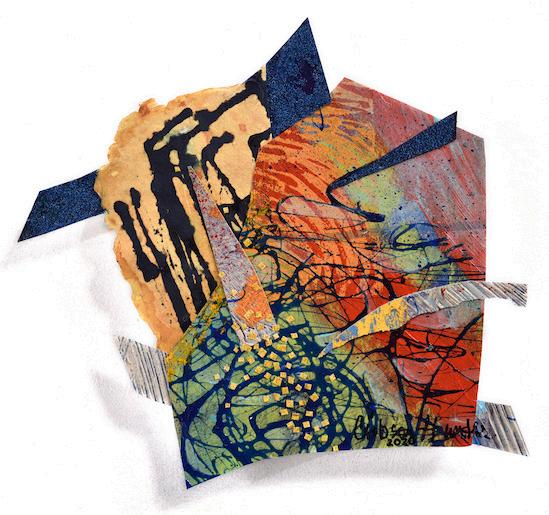
Born in Philadelphia, Pennsylvania, Aziza graduated from Temple University (B.S.) and received her M.F.A. from Howard University. Ms. Gibson-Hunter has been awarded the Individual Artist Fellowship Program Grant from the DC Commission of the Arts and Humanities numerous times. Her work can be found in the collections of the Washington, DC Art Bank, the U.S. Embassies in Liberia and Togo, as well as the collections of Montgomery County, Maryland, the National Institutes of Health, and the Boston Children’s Hospital. She has created public works for Washington, DC through the Department of General Services. These works, The Wall of Unity (2017), and ANCESTORS (2019) are both located in Washington, DC public schools.
Ms. Gibson Hunter is a member of the Black female collectives Dandelion Black, THOUGHT, and WOAUA. She is a cofounding member of Black Artists of DC and has a studio located within the STABLE art complex in Washington, DC.
Left: Claudia “Aziza” Gibson-Hunter, SomeCallMeMr.Re(SunRa), 2020, acrylic paint, colored pencil, and paper on wood panel Right: Claudia “Aziza” Gibson-Hunter, NeverTrapped(TerryLyneCarrington), 2020, acrylic paint, colored pencil, and paper on wood panelI began this project in 20 19 as a proposal for a solo exhibition that was to take place at the Hillyer Gallery in Washington, DC. My proposal was chosen, and the exhibition was to occur in October of 2020. The tentative title for the show was Gris Gris for the First Wave of the Third Millennium. A gris gris is a talisman that is filled with spiritual text. Mine would be of the 21st century with text and filled with medicinal objects. They would be mixed media, acrylic paint, and colored pencil, layered, bright, vibrant, and created through a combination of painting, collage, and printmaking. Upon pondering the future of African Americans, I had ascertained that creating gris gris would be a timely project.
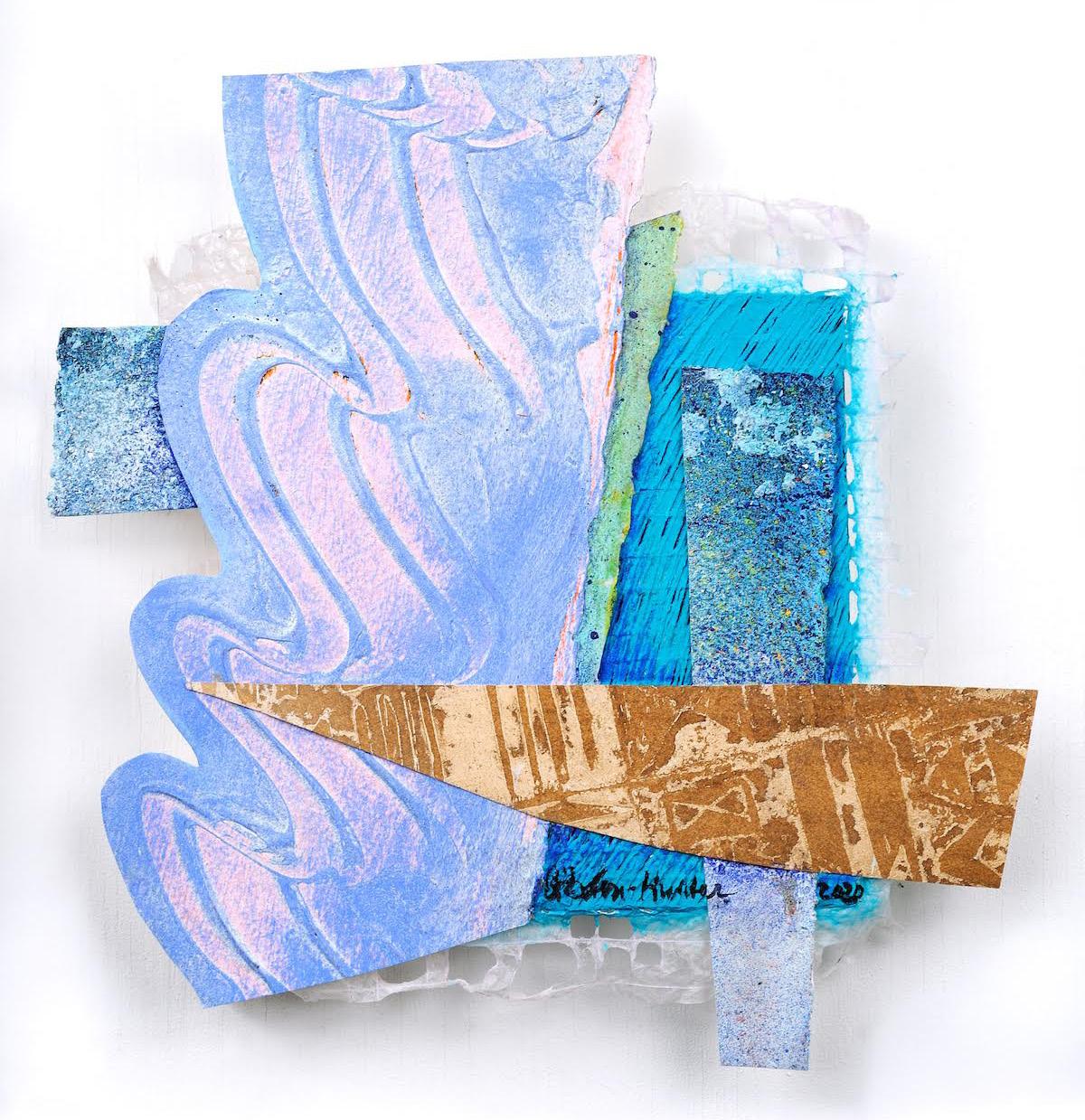
COVID-19 hit, and the show was canceled. Then Mr Floyd was murdered. I sat in my dark studio, in the quiet, trying to grapple with the magnitude of the disease, its consequences, and the numb feeling of having yet another of my people murdered.
Creating the gris gris was providing me with a sense of joy, even hope... I contacted spiritual leaders from many different belief systems and was informed by all that intent was paramount. Some suggested items to include in the works. For months I searched for raw obsidian, white sage cultivated by Native Americans, worry dolls from Guatemala, jasper, seeds from the tree of life, citron, and so many more items to disburse healing, inspiration, and protection. As for the text, I found two that I thought would be of help: The Zulu Personal Declaration and Boukman ‘s Prayer Sections of these documents, along with a variety of the objects mentioned, were sealed into the backs of each gris gris. Boundlessness is a quality I embrace, so none of the gris gris fit neatly into a rectangular or square format. They push out from their centers.
In two years, I completed 111 gris gris. Each element was matched and titled with the name of a Black musician or tune. After family, friends, and art making, it is the music of my people continues to sustain me. l hired a photographer to document the installation. The gris gris were arranged as if they were attempting to leave a white room, which for this installation symbolized the extremely limited world of whiteness.
Claudia “Aziza” Gibson-Hunter, MaryLouWilliams(MaryLou Williams), 2020, acrylic paint, colored pencil, and paper on wood panel
klorrainegraham.com
@klorrainegraham
K.Lorraine Graham was born in Norfolk and raised in Denver, La Serena, San Jose, Tabubil, Mexico City, Guangzhou, and Maine. She’s a graduate of the University of California, San Diego, where she earned an M.F.A. in interdisciplinary writing, and George Washington University, where she studied Chinese and East Asian studies. Her work has been shown at But_Also, STABLE, Washington Printmakers Gallery, and Open Studio DC, all in Washington, DC, and Maison de Cultures in Brussels and Het Zilverhof in Ghent. She has performed at Los Angeles Contemporary Exhibitions and Post Moot I and II.
She is the author of The Rest Is Censored (Bloof Books) and Terminal Humming (Edge Books), as well as Semiotic Squares, a book of drawings from Primary Writing. She has also written numerous zines and chapbooks, including My Little Neoliberal Pony (Insert Blanc).
Lorraine has taught creative writing, digital rhetoric and composition at The Corcoran, California State University, San Marcos, and the University of California, San Diego. She has also curated numerous reading and performance series, including In Your Ear at the District of Columbia Arts Center. When she lived in San Diego, she curated Agitprop, an innovative, interdisciplinary performance series for poets and artists with text-based practices. In partnership with the San Diego Museum of Art, she curated a series of bilingual readings and talks featuring writers and translators from Tijuana. Lorraine is an artist at STABLE Arts in Washington, DC, where she also lives.
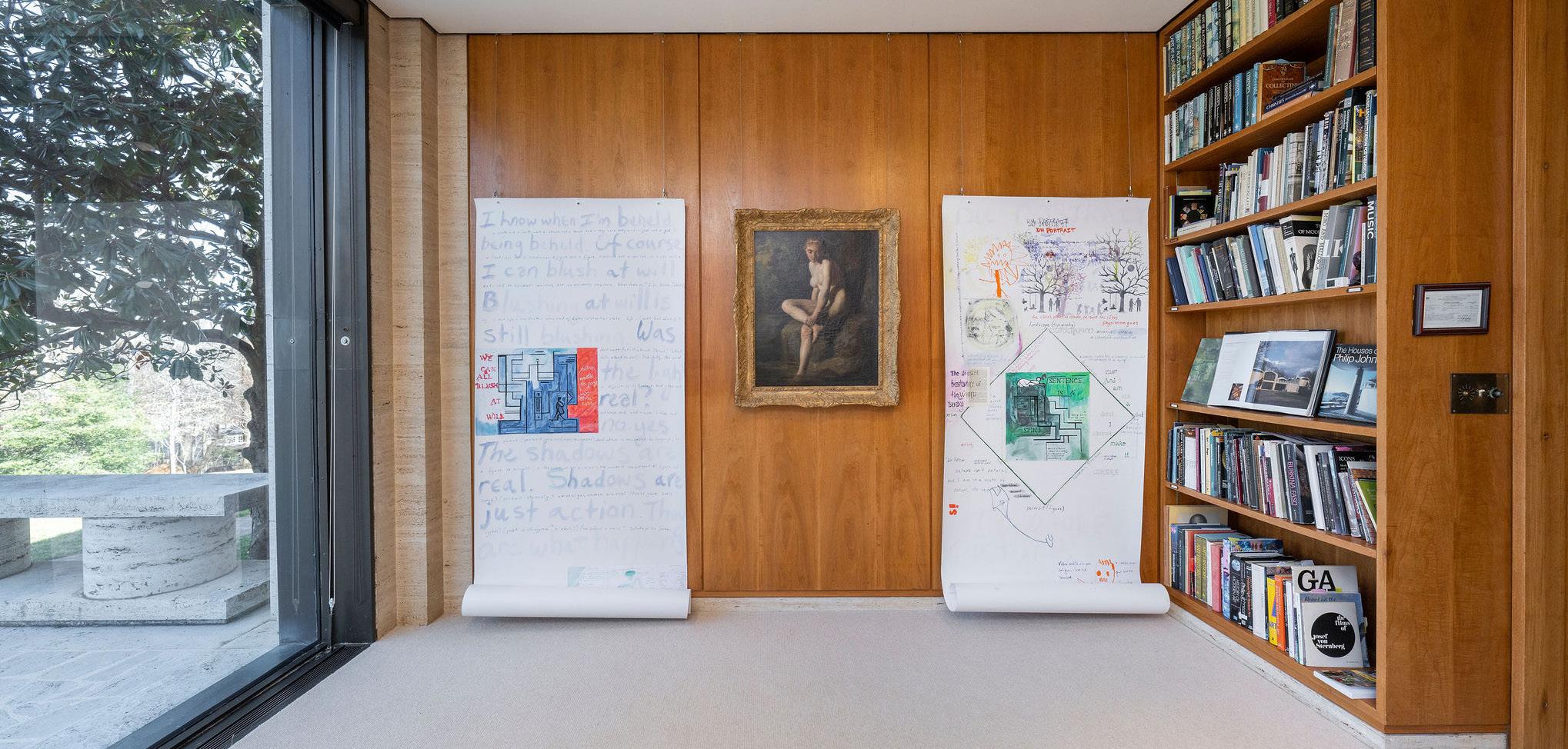 K. Lorraine Graham, Study, 2023, graphite, ink, and watercolor on paper Thomas Couture, SeatedNudeinaLandscape, n.d., oil on canvas
K. Lorraine Graham, Study, 2023, graphite, ink, and watercolor on paper Thomas Couture, SeatedNudeinaLandscape, n.d., oil on canvas
I am a language-based, multi-disciplinary artist whose work ranges from investigations of habitual life to imagining antiracist ancestral narratives. Through time-based conceptual performances documented as poems, language-diagrams, and participatory projects, I explore how habits and language shape and are shaped by cultural norms. My projects attempt to disrupt these norms as a way of disrupting white supremacy, especially as it relates to ideas of love, money, work and family.
My first two books, Terminal Humming (Edge Books: Washington, D.C.) and The Rest is Censored (Bloof Books: Blue Hill, Maine) are both records of conceptual experiments. I made Terminal Humming by using every possible lunch break to sit in a public place and write about the relationship between love and economics based on overheard conversation and found text. To make The Rest is Censored, I turned my hourlong bus commute into a daily durational performance. My two rules were 1) always sit next to someone and 2) write until you are too nauseous to continue.
Through language and language-based works on paper, I document and reimagine the tasks and gestures required to support and care for oneself and others. By creating poems and drawings that emerge from performances and processes exploring everyday life, I aim to offer new and strange strategies for material, emotional, intellectual and creative survival. Imbued with a sense of humor and sadness, my work points to the possibility of thriving despite the disembodied, frenetic, neoliberal demand for productivity. While drawing on routines and constraints specific to my life and history, I hope the audience can reflect on the subversive, transformative potential that can emerge from even the most laborious and banal activities of their daily lives.
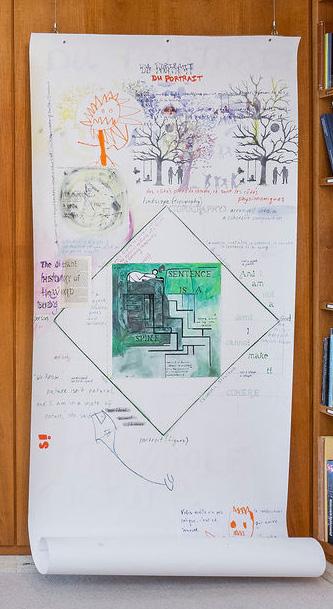
jeanjinhokim.com
@jeanjinhokim
Jean Kim’s work of art reflects ideas of interconnectivity, community, and cultural dialogue that challenge social norms and boundaries.
Jean Kim earned her B.F.A. in painting from West Virginia University in Morgantown, focusing on abstract paintings and landscapes. In 2016, she received her M.F.A. in studio art from American University in Washington, DC. Throughout the early 2010s, Jean Kim moved away from painting and began experimenting with found art and mixed media. She began using ordinary household items that were seemingly insignificant and transformed them into something extraordinary through her art. The idea of transformation, validation, and empowerment is present throughout all of her work and continues to be a source of her inspiration. After the 2020 pandemic, her medium drastically became more minimalistic and focused on the conceptual transformation of ideas through her art. Though the medium has drastically changed, the idea of transformation and empowerment became more direct and potent.
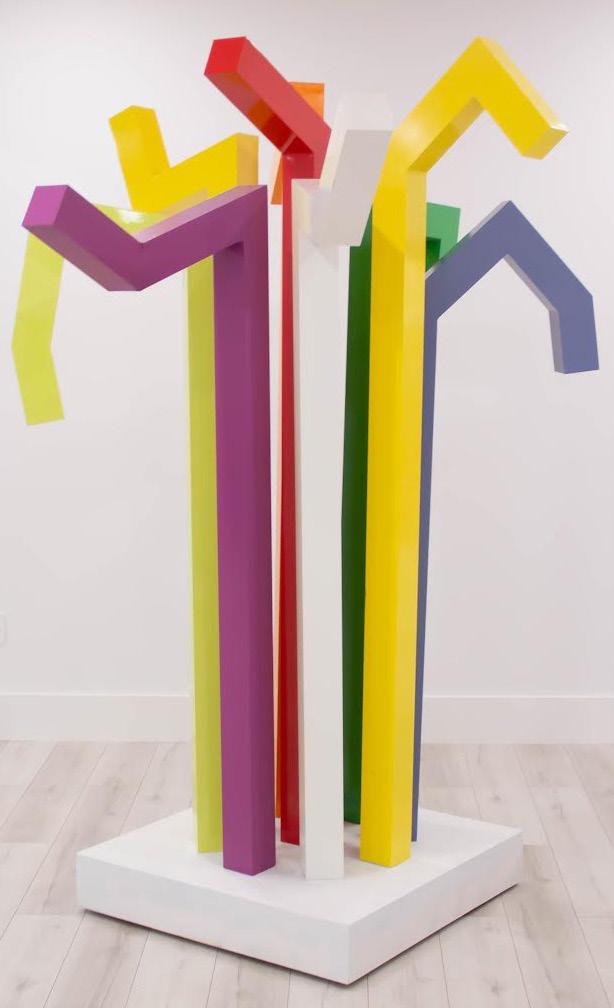
Warm Vibe II is an abstract representation of the everyday internal and emotional struggles, resilience, hope, and happiness of humanity during the difficult time of the COVID-19 pandemic using a spectrum of color and figurative gestures. Color can influence our moods and feelings and often set the tone to a movie, art, or even our identity. The colors give a different mood and personality to the sculptures. As a whole, the delightful display is intended to amuse the eyes and create a good vibe in the atmosphere as we emerge from the isolation of the pandemic. This piece compliments Thomas Downing’s work Universal Joint.
Thomas Downing belonged to the Washington Color School Movement that started in Washington DC. This focus on color and the calmness evoked is familiar visually and emotionally. The harsh lines, bright colors and the bending of lines are all present in the form of abstract-representationalism.
Jean Jinho Kim has been the subject of one-artist exhibitions at Interconnection, curated by Grace Ji, Korean Community Center, Tenafly, NJ (2022); Thinking Out Loud, curated by Judy Southerland, Studio Gallery, Washington, DC. (2020); Big Leap, curated by Susan Main; VisArts 355 Pod Space, Rockville, MD (2020); and Overlooked Perspective, Gilchrist Museum of the Arts, Cumberland, MD (2018). Significant recent group exhibitions include Soft Power, Pazo Gallery, South Kensington, MD (2022); Boundless, Korean Culture Center, Washington DC (2022); Inside Outside, Upside Down, The Philips Collection, Washington DC (2021); and Deep Flash, Vis Arts, Rockville, MD (2018).

Leah Lewis is an artist and mother from Beaver Falls, Pennsylvania who is currently based in Washington, DC.She is a past participant of The Artist’s Mother’s Studio at the Washington Project for the Arts and has been commissioned for public art projects through DC’s Department of General Services. She is a current resident of STABLE Arts.
I am interested in texture, corrosion/decay, and American Culture. Developing a personal language—or code through which objects and environment double as a sort of ink blot test for the viewer—is something that I have been exploring. I find magic in the mundane.
I challenge myself to begin artworks with abstract geometrical concepts and finish them as still life in domestic settings, incorporating the range of mediums that I have studied through the years.


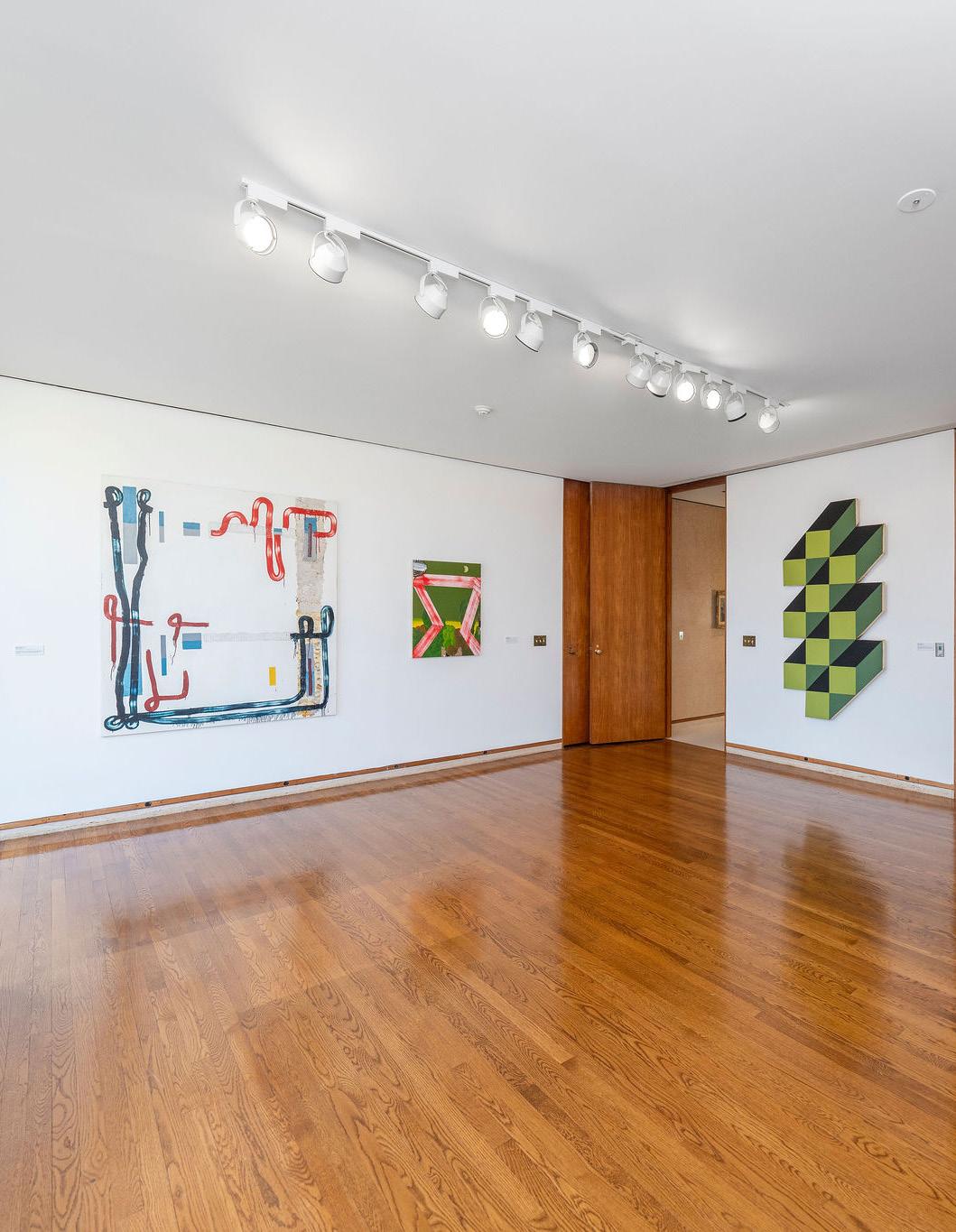
matthewjmann.com @metamuslix
Matthew Mann is an artist living and working in Washington, DC. Recent exhibitions include INTERLUDE at The Kreeger Museum in Washington DC; Fixer Upper at Trestle Gallery in Brooklyn, NY; Mod Cons at Brick Red in New Orleans, LA; and Luxury Trouble at Studio 1469 in Washington, DC.
Mann has received grants from the DC Commission on the Arts and Humanities and he has been a visiting artist at George Washington University, JOYA: Arte y Ecologia in Almeria, Spain, The Luce Foundation Center at the Smithsonian American Art Museum, and Maryland Institute College of Art.
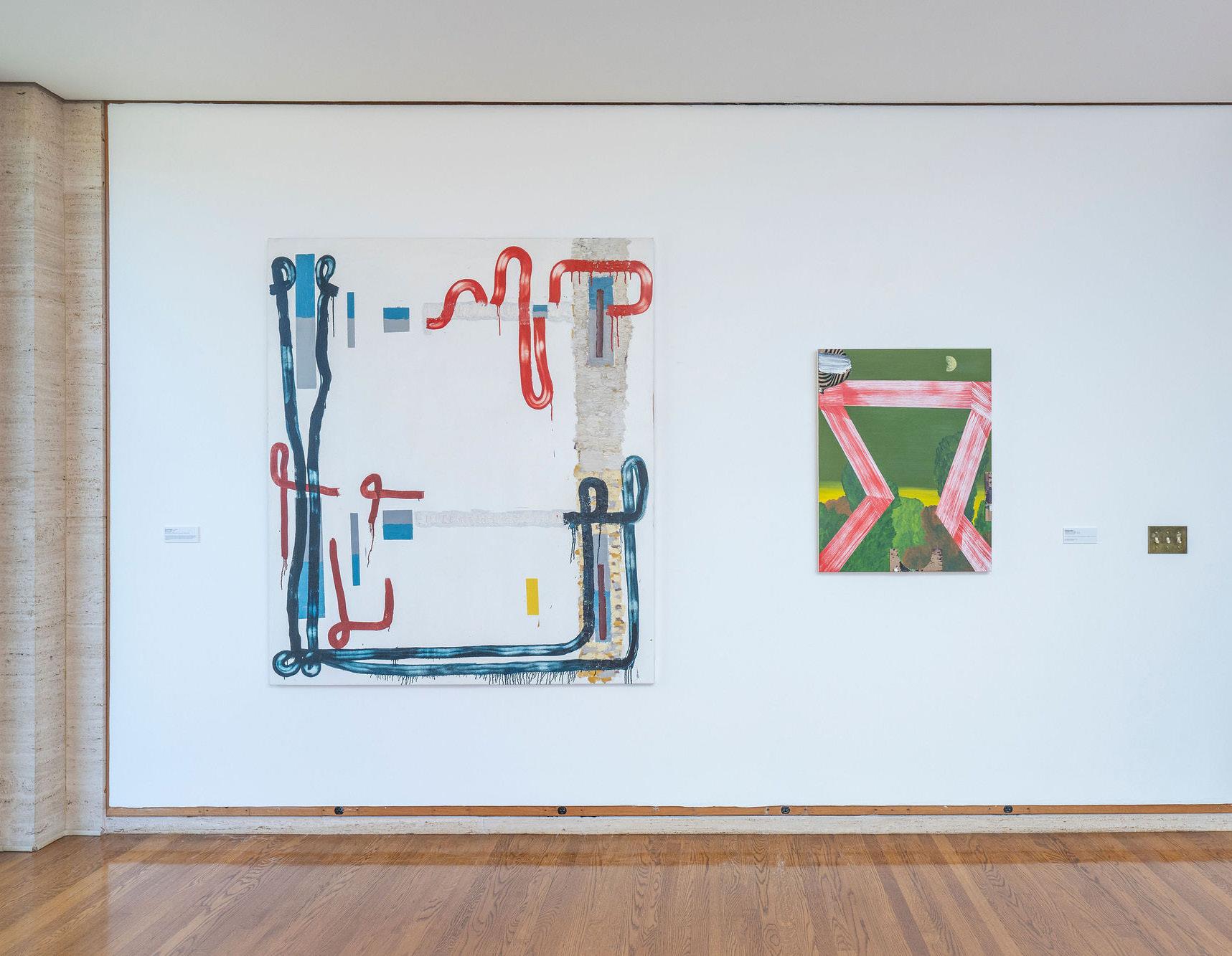 David Urban, Band of Hope, 1996, oil on canvas
Matthew Mann, MoonlightSinew, 2022, oil, acrylic, and collage on canvas Page 34: Clark V. Fox, The Three Crosses, 1968, acrylic on canvas
David Urban, Band of Hope, 1996, oil on canvas
Matthew Mann, MoonlightSinew, 2022, oil, acrylic, and collage on canvas Page 34: Clark V. Fox, The Three Crosses, 1968, acrylic on canvas
Creating paintings that resemble the feeling of cohering narrative meaning out of a visual experience is at the heart of my painting practice. This is born out of an interest in how images work on us, how they describe and change the visual experience through their pictorial structures and delivery mechanisms. Through painting, printmaking and collage, my paintings create a web of associative possibilities that enable viewers to overlay their own knowledge and experiences while reflecting the cultural environment in which they are made.

Overall Moonlight Sinew has a lot to do with formal considerations - abstractly interestingly dividing the rectangle - as well as conceptual considerations relating to how narratives form based on visual experience. The painting started only as that shape at the center of the painting. I had it sitting around as a study on a piece of watercolor paper for about a year before fully committing to the idea. The central shape, the beams that jut through the image, was adapted from Georges Braque’s billiard table paintings. The disjointed edges of that shape echoed how I was feeling about some of the other subject matter in the painting - Thomas More’s Utopia for one - as well as a sense of foreboding and strain that I was feeling at the time related to being a new parent in a pandemic, being an artist, and so on.
A word like “sinews” brings strain to mind for me: the strain of the process of wrangling a narrative out of a visual experience, the physical strain of working on a painting, being a parent, riding a bicycle through traffic, and so on. The painting’s title is meant to summon that sense of strain. The “Moonlight” part of the title, and the moon’s presence in the painting, is owed to my young son’s fascination with the moon. This painting, and a handful of other recent paintings, is simply a way of bringing him into the work.
katherinemann.net @ktzulan
Katherine Tzu-Lan Mann creates large scale paintings and paper installations that examine mythology, identity, and landscape. She is the recipient of the Sustainable Arts Foundation grant, a Fulbright grant, the AIR Gallery and Lower East Side Printshop Keyholder Fellowships, and the Mayor’s Award and Hamiltonian Fellowship in Washington, DC. Some of the venues where Mann has shown her work include The Kreeger Museum, Academy Art Museum, Walters Art Museum, American University Museum, Tides Museum, Corcoran Gallery of Art, Rawls Museum, the US consulate in Dubai, UAE, and the US Embassy in Yaounde, Cameroon.
I examine landscape painting, environment, and cultural estrangement by building luxuriant, cinematically scaled paper paintings and installations. These combine romantic, utopian, and immersive sensibilities from both Chinese and Western landscape painting with a lexicon drawn from a personal mythology informed by my identity as a biracial, second generation Asian American: ribbons, baubles, bats, peaches, sperm, piles of flowers repeated so many times as to appear biomorphic and alien, but bursting with incongruous efflorescence. These pieces have two primary concerns: the exploration of landscape in a world where “landscape” is defined through an ever-widening field of digital, graphic, and visual forms, and the insertion of personal world building—a world of fragmentation, hybridity, and incongruity—into that history.
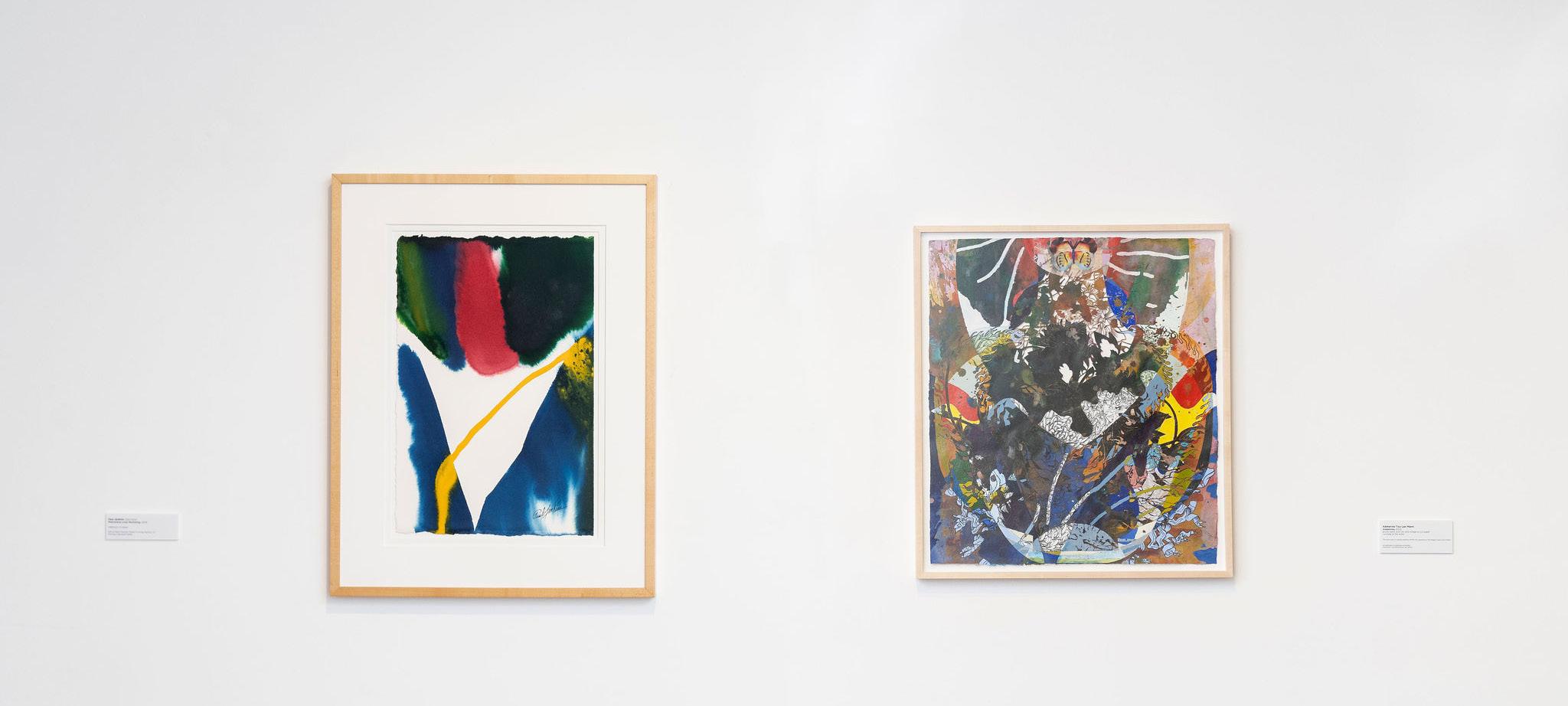 Paul Jenkins, PhenomenaLunarReckoning, 2008, watercolor on paper Katherine Tzu-Lan Mann, Analemma, 2023, acrylic paint, sumi ink, and collage on cut paper Page 39: Gene Davis, Untitled,1969, acrylic on canvas
Paul Jenkins, PhenomenaLunarReckoning, 2008, watercolor on paper Katherine Tzu-Lan Mann, Analemma, 2023, acrylic paint, sumi ink, and collage on cut paper Page 39: Gene Davis, Untitled,1969, acrylic on canvas
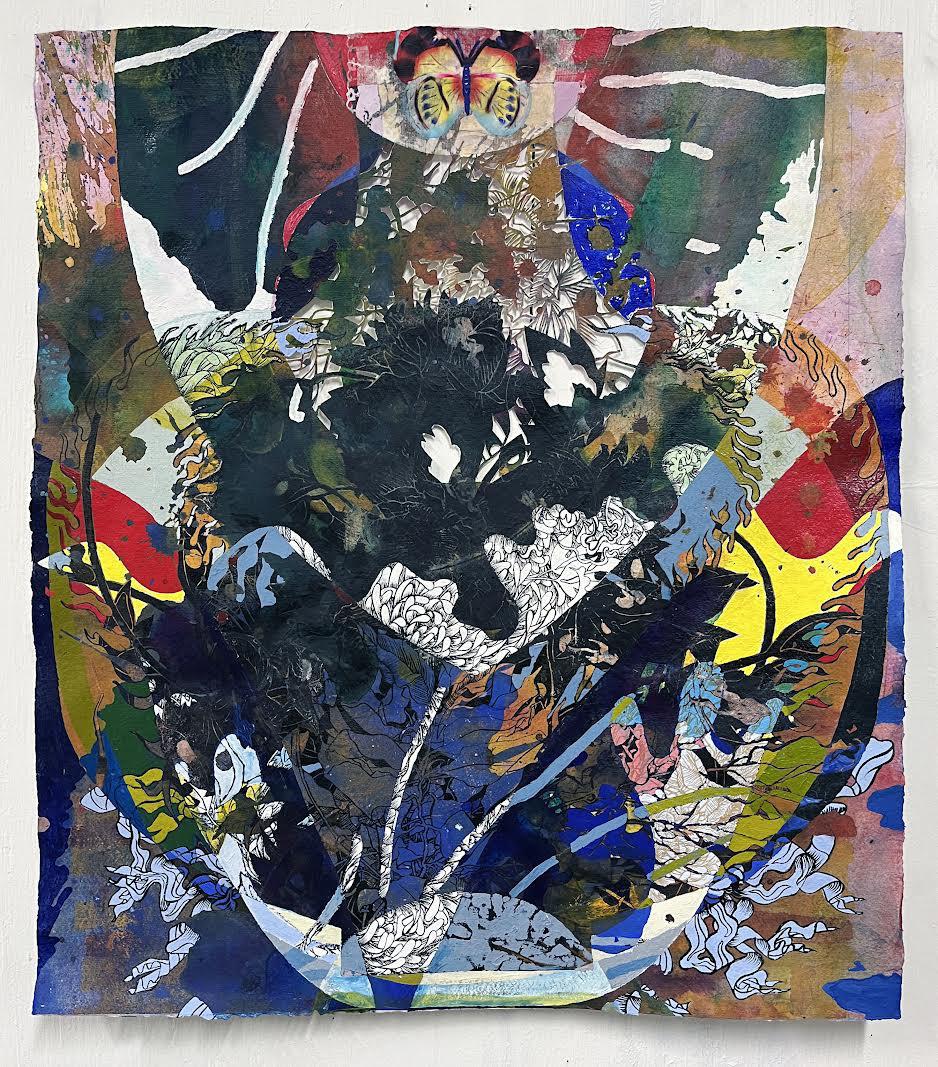


gailshaw-clemons.com
Gail Shaw-Clemons, born in Washington, DC, is a printmaker, mixed media artist, and activist. She received her Master’s Degree in Lithography from the University of Maryland. She has exhibited extensively, with many works included in public and private collections in the USA, Brazil, Norway, Sweden, China, and the Republic of Ireland. Her work is also in the collection of the National Museum of Women in the Arts, Library of Congress, and the Banneker-Douglass Museum. Shaw-Clemons has a studio at STABLE Arts and prints at the Bob Blackburn Printmaking Studio in New York as well as the Pyramid Printmaking Studio in Hyattsville, MD.Recently retired as an art instructor from the United Nations International School in New York, she is currently an adjunct professor at Bowie State University in Maryland.
Gail Shaw-Clemons, Mask#3, 2021, lithograph on gel medium
Guro or Yaure Artist, FaceMask,Côte d’Ivoire, wood
Gail Shaw-Clemons, Mask#0, 2021, lithograph on gel medium
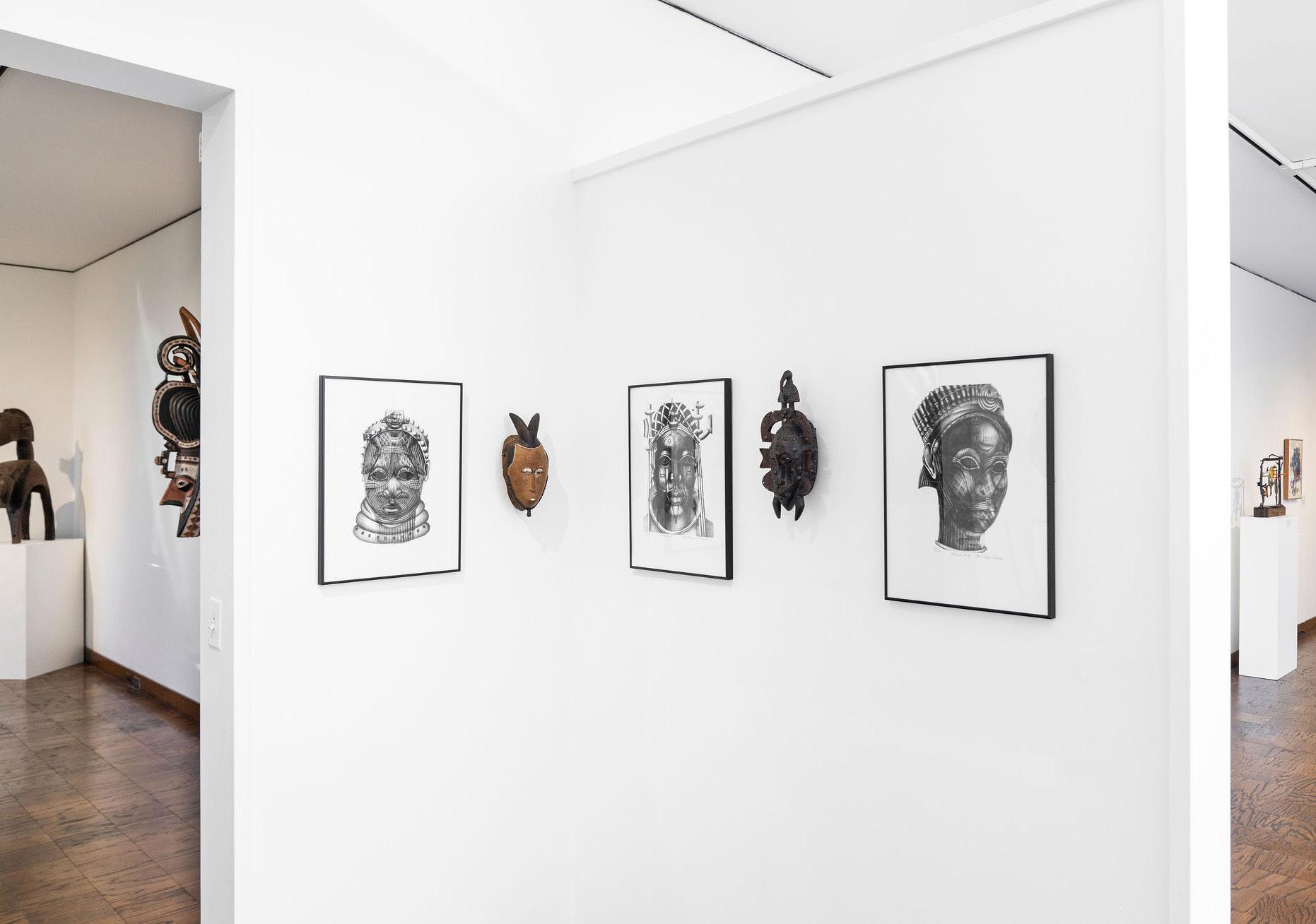
Senufo Artist, FaceMask(Kpeli-yëhë),Côte d’Ivoire, wood and brass studs
Gail Shaw-Clemons, Mask#8, 2021, lithograph on gel medium
My work addresses the overwhelming respect I have for African masks. The mask represents spirits of ancestors past, yet many are extremely futuristic. It is ironic that the African mask inspired Modern art {representing the past while inspiring the future}. They really embodied the term “back to the future.”


The challenge with the initial drawings of these masks became “how make them my own?” I thought about the mask as embodying the spirit of my ancestors and began to envision the mask as transparent in order to achieve a spiritual effect. With much experimentation, I turned the drawings into lithographs while adding at least 30 layers of gel medium to each. I soaked them in water and removed the paper, leaving just the image encased in clear plastic. The transparencies inspired me to overlap different masks with endless possibilities. This process empowered me to achieve my goal of creating mysterious effects, while calling up the ancestors deep within.
I discovered a poem by an African American poet, Paul Laurence Dunbar, entitled “We Wear the Mask”, where a connection to African Americans was made. The poem focused on the metaphorical “mask” of happiness and contentment that African Americans were forced to wear in front of white society while struggling under racism and segregation. This poem was written before the Civil Rights movement and speaks to the struggles of African Americans forced to navigate a racist American society. Through his poem, the mask became even more meaningful to me.
mollyspringfield.com
@mollyrspring
Molly Springfield’s text-based drawings have been exhibited widely, including solo exhibitions in New York, Chicago, San Francisco, Washington, DC, and Cologne, Germany, as well as significant museum exhibitions including Drawing Time, Reading Time at The Drawing Center and Graphite at the Indianapolis Museum of Art.
Reviews of Springfield’s work have appeared in Artforum, Art Papers, Modern Painters, The New York Times, Village Voice, and Washington Post. Her work is also featured in the anthologies The Thing The Book: A Monument to the Book as Object and It Is Almost That: A Collection of Image + Text Work by Women Artists & Writers
Springfield’s work is in the permanent collections of the Whitney Museum of American Art and the Metropolitan Museum of Art. She received her M.F.A. from the University of California, Berkeley in 2004, was a participant at Skowhegan in 2006, and a MacDowell Fellow in 2016.


I make graphite drawings that use photocopies of printed texts as their source material. I’m influenced by the history of reproduction: in art (19th-century trompe l’oeil, 1960s Conceptual art’s use of the Xerox); in literature (practices of translation and transcription); in technology (the digitization of texts, the rise of e-readership). I ask how key moments within that history fundamentally transform the way that we experience language.
I usually develop my projects over a period of many years through in-depth research and painstaking manual labor. My past projects include an interactive archive of marginalia; drawings of photocopies of books about conceptual art; my own “translation” of Marcel Proust’s In Search of Lost Time in the form of drawings; and investigations into the proto-history of the Internet, and the invention of calotype photography in the 1830s.
My most recent project considers the process of transcription and the development of modernism through the writings and photography of Virginia Woolf. The drawings are primarily inspired by two sources: a holograph draft of Woolf’s novel To the Lighthouse and reproductions of her personal family photo albums.

andyyoder.com
@andyyoderart
Andy Yoder’s work is in numerous public and private collections, and exhibitions include shows at the Brooklyn Museum of Art, the Queens Museum of Art, Winkleman Gallery in New York, and the American Academy of Arts and Letters. His work has been reviewed in The New York Times, The Wall Street Journal, The New Yorker and Art in America. Commissions include works for ESPN, Continental Airlines, Progressive Insurance, David and Susan Rockefeller, and the Saatchi Collection. He currently maintains a studio at STABLE Arts in Washington, DC, and was recently awarded a grant from the Corcoran Women’s Committee.
My first visit to the museum was on a gorgeous fall day. During a walk outside I found a magnolia seed pod perched on a step, and I immediately decided to keep it. Then I began collecting leaves, and it was then that I came up with the concept of an interior leaf pile. I thought it would be a way of acknowledging my favorite aspect of the Philip Johnson building, with its floor to ceiling windows: the way that inside and outside flow together.
The idea of using salvaged auto parts to create the leaves sprang from Mr. Kreeger’s bio in the entry hall. Among his many accomplishments, I learned that he had been President, Chairman, and CEO of Geico Insurance. It struck me that car accidents, often the most raw, painful experiences we can have, helped provide the resources to build a temple of refinement devoted to the arts. Like many contradictions, the two sides are joined at the hip.
 Andy Yoder, Pileup, 2023, salvaged auto parts
Andy Yoder, Pileup, 2023, salvaged auto parts
yingzhu.org
@yings_chapter
Ying Zhu was born in the midwest region of China. As a young adult she chased a big city dream to Beijingbut it somehow led her to Omaha, Nebraska. She now lives and works in Washington, DC. She received an M.F.A. from University of Nebraska-Lincoln in 2010.
Zhu’s work has always been tied to the self in the context of the world around us. In her site-specific installations, she methodically draws out the relationships between action and consequence. Through intuitive manipulations, material becomes the threshold of her work with its color, texture, and inherent functions.
A former artist-in-residence at the Bemis Center for Contemporary Art, Vermont Studio Center, and at Headland Center for the Arts. Her work has been exhibited in solo exhibitions including Sugar Coated at ALH, Houston, TX; Live Like an Astronaut at KelinSun, New York, NY; and Please Watch Your Step at the Museum of Nebraska Art, Omaha, NE. Group exhibitions include Dialogue at STABLE, Washington, DC; Landing at MOCA, Taiwan; Magical Thinking at Roots Division, San Francisco, CA; III Moscow Young Art Biennale in Moscow, Russia; and Mind the Gap at Neukolln Art Festival Nacht Und Nebel in Berlin, Germany. She is the recipient of the NAC Distinguished Artist Grant.

My experience as an immigrant has stimulated the searching nature of my work and inspires me to negotiate with ideas that explore the confluence of cultures and identities. I am interested in the intricate behavior of changes while the understood perceptions are challenged, which causes an immediate shifting of senses.
I emphasize on the sophistication in detail, but simplicity in structure. Employing natural material such as eggshells, I aim to form a symphony of elements with reassuring rhythms and reference the delicate balance we encounter in nature. The unexpected approach with ordinary material will amplify the fragile, ephemeral, and poetic qualities within and beyond our habitual perceptions. Material is the threshold of this work with its color, texture, and inherent functions. Process and labor are integral, and through repetition that time becomes an object of the work as well. The form dematerializes and important qualities such as fragility, empathy, and playfulness emerge out of my interpretations of the liminal state.
 Clark V. Fox, The Three Crosses, 1968, acrylic on canvas Ying Zhu, throughthecubes, 2022, eggshells on foamcore Thomas Downing, UniversalJoint, 1966, acrylic on canvas
Clark V. Fox, The Three Crosses, 1968, acrylic on canvas Ying Zhu, throughthecubes, 2022, eggshells on foamcore Thomas Downing, UniversalJoint, 1966, acrylic on canvas
This catalogue was produced in conjunction with an exhibition featuring artists from STABLE and organized by The Kreeger Museum.
The Kreeger Museum
Washington, DC
February 11th, 2023-March 25th, 2023
Published in the United States by The Kreeger Museum
2401 Foxhall Road NW
Washington, DC 20007 www.kreegermuseum.org
Helen Chason, Director
Anna Savino, Designer
STABLE
336 Randolph Place, NE Washington, DC 20002 www.stablearts.org
Maleke Glee, Executive Director
Silky Sullivan, Design Consultant
Image Captions:
Cover: Matthew Mann, MoonlightSinew
Page 4: Clark V. Fox, The Three Crosses, 1968, acrylic on canvas; Ying Zhu, throughthecubes, 2022, eggshells on foamcore
Page 6: Andy Yoder, Pileup, 2023, salvaged auto parts; Claudia “Aziza” Gibson Hunter, GrisGrisfromtheFirstWaveoftheThirdMillennium, 2020, acrylic paint, colored pencil, paper on wood panel
Image Credits:
AllimagesarecreditedtoAnneKimunlessotherwise noted.
Cover Image: Courtesy of Matthew Mann
Pages 13-14: Courtesy of Leigh Davis
Page 17: Courtesy of Rex Delafkaran
Page 19: Courtesy of Tim Doud
Pages 25-26: Courtesy of Claudia “Aziza” Gibson-Hunter
Page 30: Courtesy of Jean Kim
Page 32: Courtesy of Leah Lewis
Page 36: Courtesy of Matthew Mann
Page 38: Courtesy of Katherine Tzu-Lan Mann
Page 42: Courtesy of Gail Shaw-Clemons